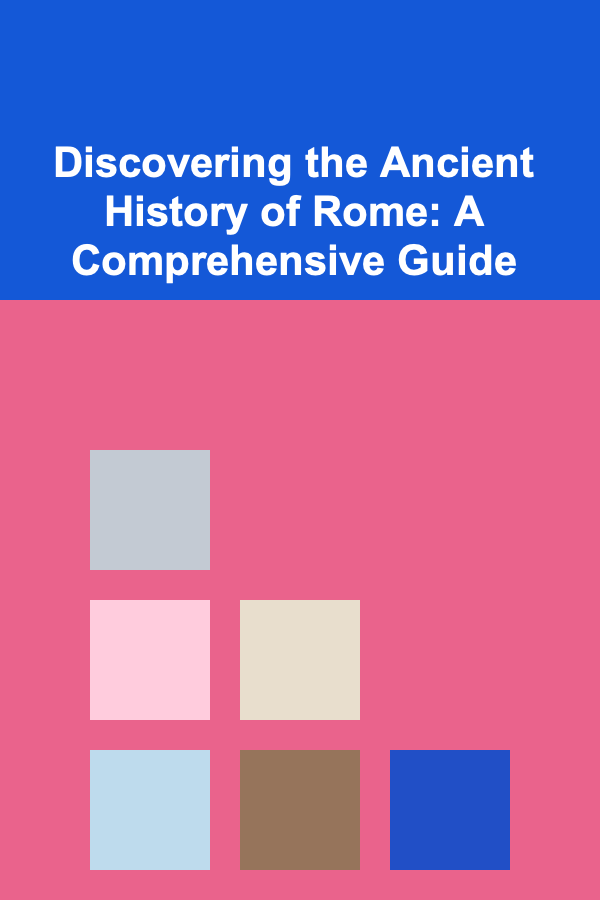
Discovering the Ancient History of Rome: A Comprehensive Guide
ebook include PDF & Audio bundle (Micro Guide)
$12.99$9.99
Limited Time Offer! Order within the next:

Ancient Rome, a civilization that once dominated the Mediterranean world and left an indelible mark on law, architecture, language, and culture, continues to fascinate and inspire. Unearthing the secrets of this powerful empire requires a multi-faceted approach, combining archaeological exploration, literary analysis, numismatic study, and a critical understanding of the socio-political forces that shaped its rise and fall. This guide will provide a detailed roadmap for anyone interested in discovering the rich tapestry of ancient Roman history.
I. Foundations: From Myth to Monarchy (753 BCE -- 509 BCE)
The story of Rome begins with legend, shrouded in myth and interwoven with the founding by Romulus and Remus in 753 BCE. While the accuracy of this date and narrative is debated, it serves as a symbolic cornerstone for the civilization that would follow. To delve into this era, one must sift through legend and historical probability.
A. Unraveling the Myths: Romulus, Remus, and the Aeneid
The tale of Romulus and Remus, raised by a she-wolf and ultimately clashing over the location of their city, provides a foundation myth infused with themes of fratricide, ambition, and divine intervention. Virgil's Aeneid, written centuries later, connects Rome's origins to the Trojan hero Aeneas, linking Roman identity to a glorious past. While these narratives are not historical accounts, they offer valuable insights into the Roman worldview, their aspirations, and their understanding of their place in the world. Consider the function of these myths: to legitimize power, to provide a sense of shared identity, and to connect Rome to a larger, more ancient Mediterranean heritage.
B. Archaeological Evidence: The Earliest Settlements
Archaeological excavations on the Palatine Hill and surrounding areas have revealed evidence of settlements dating back to the 8th century BCE, confirming that the area was inhabited long before the traditional founding date. These early settlements were likely small, agrarian communities engaged in trade and agriculture. Look for evidence of hut foundations, pottery shards, and burial sites. The findings at the Roman Forum, while later constructions, often overlie and reveal clues about these earlier settlements. Examine the stratigraphy of the archaeological layers to understand the sequence of habitation and development.
C. The Seven Kings: A Transition to Republic?
According to tradition, Rome was ruled by seven kings after Romulus. These kings, both legendary and potentially historical, represent a period of transition from a small settlement to a more organized city-state. Romulus, Numa Pompilius, Tullus Hostilius, Ancus Marcius, Tarquinius Priscus, Servius Tullius, and Tarquinius Superbus each contributed, according to the narratives, to Rome's religious, legal, and military institutions. The last king, Tarquinius Superbus (Tarquin the Proud), was overthrown in 509 BCE, leading to the establishment of the Roman Republic. Debate surrounds the historicity of these kings; some scholars believe they represent Etruscan influence over Rome. Analyzing the legends associated with each king reveals insights into the values and priorities of early Roman society. For example, Numa Pompilius is credited with establishing Roman religious practices, suggesting the importance of religion in early Roman identity.
II. The Republic: Expansion and Internal Strife (509 BCE -- 27 BCE)
The Roman Republic, established in 509 BCE, marked a pivotal shift in Roman governance. Power was theoretically vested in the Senate and the Roman people, although in reality, aristocratic families wielded considerable influence. This period witnessed remarkable territorial expansion, driven by military prowess and strategic alliances, but also marked by intense internal struggles between patricians (the aristocratic elite) and plebeians (the common citizens).
A. The Struggle of the Orders: Patricians vs. Plebeians
The early Republic was characterized by a constant power struggle between the patricians and plebeians. Plebeians, initially excluded from high office and legal protections, fought for greater political and economic rights. This struggle resulted in key concessions, including the establishment of the office of Tribune of the Plebs (tribuni plebis), who could veto acts of the Senate that were deemed harmful to plebeian interests, and the codification of laws in the Twelve Tables (Leges Duodecim Tabularum), displayed publicly in the Forum. Studying the Twelve Tables provides insight into early Roman law and social norms. The Lex Hortensia (287 BCE), which made plebiscites (resolutions passed by the Plebeian Council) binding on all Roman citizens, marked a significant victory for the plebeians, although the patricians continued to exert significant influence.
B. Military Expansion: Conquering Italy and Beyond
The Republic's success was largely due to its formidable military machine. The Roman legions, highly disciplined and effectively organized, conquered much of Italy, defeating the Etruscans, Samnites, and other Italic tribes. The Punic Wars against Carthage (264-146 BCE) were particularly crucial, establishing Rome as the dominant power in the Mediterranean. Hannibal's invasion of Italy during the Second Punic War tested Rome's resilience, but ultimately resulted in Carthage's destruction. Following the Punic Wars, Rome expanded its influence into Greece, Spain, and North Africa. Analyze the military strategies and logistical capabilities that enabled Rome's territorial expansion. Consider the impact of these conquests on Roman society, economy, and culture. The influx of wealth and slaves led to social and economic inequalities, contributing to further internal strife.
C. The Late Republic: Crisis and Collapse
The late Republic (c. 133-27 BCE) was a period of intense political instability, marked by the rise of powerful generals, civil wars, and the erosion of republican institutions. The Gracchi brothers, Tiberius and Gaius Gracchus, attempted to address land inequality and other social problems through radical reforms, but were both assassinated by their political opponents. The Marian Reforms, introduced by Gaius Marius, transformed the Roman army from a citizen militia to a professional force, loyal to its commander rather than the state. This paved the way for powerful generals like Sulla, Pompey, and Julius Caesar to challenge the authority of the Senate. Caesar's conquest of Gaul and his subsequent crossing of the Rubicon led to a civil war against Pompey, culminating in Caesar's victory and his appointment as dictator perpetuo (dictator for life). Caesar's assassination in 44 BCE did not restore the Republic, but rather triggered another period of civil war between his supporters (led by Mark Antony and Octavian) and his assassins (led by Brutus and Cassius). The Second Triumvirate, formed by Antony, Octavian, and Lepidus, ultimately collapsed, leading to a final showdown between Antony and Octavian. Octavian's victory at the Battle of Actium in 31 BCE marked the end of the Republic and the beginning of the Roman Empire.
III. The Empire: Pax Romana and Decline (27 BCE -- 476 CE)
The Roman Empire, inaugurated with Octavian's assumption of the title Augustus in 27 BCE, ushered in a period of relative peace and prosperity known as the Pax Romana. Under the emperors, Rome reached its greatest territorial extent, and Roman culture flourished. However, internal problems, external pressures, and ultimately, the division of the Empire led to its eventual decline and fall.
A. The Principate: Augustus and the Julio-Claudians
Augustus, while maintaining the facade of republican institutions, effectively established an autocratic regime known as the Principate. He reformed the Roman government, military, and economy, laying the foundation for the long period of peace and prosperity that followed. The Julio-Claudian dynasty, which followed Augustus, included emperors like Tiberius, Caligula, Claudius, and Nero. Their reigns were marked by both successes and excesses, and the dynasty ended with Nero's suicide in 68 CE. Study Augustus's Res Gestae Divi Augusti (Deeds of the Divine Augustus), an autobiographical account of his achievements, provides valuable insight into his policies and propaganda. Consider the strategies Augustus used to consolidate his power and maintain stability. Analyze the reigns of the Julio-Claudian emperors, examining the evidence for their alleged madness and tyranny, and considering the biases of the historical sources.
B. The Flavians and the Five Good Emperors
The Flavian dynasty (Vespasian, Titus, and Domitian) restored order after the chaos of the Year of the Four Emperors (69 CE). Vespasian, a successful general, rebuilt the Roman economy and began construction of the Colosseum. Titus ruled for a short but popular reign, marked by the eruption of Mount Vesuvius and the destruction of Pompeii and Herculaneum. Domitian, while initially effective, became increasingly autocratic and was assassinated in 96 CE. The Nerva-Antonine dynasty, also known as the Five Good Emperors (Nerva, Trajan, Hadrian, Antoninus Pius, and Marcus Aurelius), is considered a golden age of the Roman Empire. These emperors were known for their wisdom, justice, and concern for the welfare of their subjects. Trajan expanded the Empire to its greatest territorial extent, while Hadrian focused on consolidating existing borders and constructing defensive fortifications like Hadrian's Wall in Britain. Marcus Aurelius, a Stoic philosopher, wrote the Meditations, a timeless work of wisdom and self-reflection. Consider the factors that contributed to the stability and prosperity of the Roman Empire under the Five Good Emperors. Analyze the political philosophies and policies of each emperor, and their impact on Roman society.
C. Crisis of the Third Century and the Dominate
The Crisis of the Third Century (235-284 CE) was a period of intense political, economic, and military turmoil. Frequent civil wars, barbarian invasions, and economic instability threatened the survival of the Empire. Emperors rose and fell rapidly, often assassinated by their own troops. The Sasanian Empire in Persia posed a significant military threat. Diocletian, who came to power in 284 CE, implemented radical reforms to stabilize the Empire. He divided the Empire into two halves, East and West, each ruled by an Augustus and a Caesar (a junior emperor). This system, known as the Tetrarchy, was intended to provide more effective governance and defense. Diocletian also reformed the Roman army, economy, and administration. His reforms, while effective in the short term, ultimately contributed to the long-term division of the Empire. Constantine the Great, who came to power in 306 CE, continued Diocletian's reforms, but also made a number of significant changes. He legalized Christianity in 313 CE with the Edict of Milan and established Constantinople as the new capital of the Roman Empire. Constantine's conversion to Christianity had a profound impact on Roman society and culture. The Dominate, established by Diocletian and further developed by Constantine, marked a shift towards a more centralized and autocratic form of government. The emperor was now seen as a divine figure, and the Senate lost its remaining power.
D. The Fall of the Western Roman Empire
The Western Roman Empire faced increasing pressure from barbarian invasions throughout the 4th and 5th centuries CE. The Visigoths, Vandals, Huns, and other Germanic tribes crossed the borders and settled within Roman territory. The Western Roman emperors were often weak and ineffective, and unable to effectively defend the Empire. In 410 CE, the Visigoths sacked Rome, a symbolic blow to the Empire's prestige. In 476 CE, the last Western Roman Emperor, Romulus Augustulus, was deposed by the Germanic chieftain Odoacer. This event is traditionally considered the end of the Western Roman Empire. The Eastern Roman Empire, also known as the Byzantine Empire, continued to thrive for another thousand years. The reasons for the fall of the Western Roman Empire are complex and multifaceted. Factors include: internal political instability, economic decline, barbarian invasions, overexpansion, and the rise of Christianity (which some argue undermined traditional Roman values). Studying primary sources from this period, such as the writings of Ammianus Marcellinus, provides valuable insight into the challenges faced by the late Roman Empire.
IV. Key Resources for Discovering Ancient Rome
Unlocking the secrets of ancient Rome requires engaging with a variety of resources, each offering a unique perspective on the past.
A. Archaeological Sites and Museums
Visiting archaeological sites and museums is essential for experiencing the physical remains of ancient Rome. Some key sites include:
- The Roman Forum: The heart of ancient Rome, containing the ruins of temples, basilicas, and other important public buildings.
- The Colosseum: The iconic amphitheater where gladiatorial combats and public spectacles were held.
- The Palatine Hill: One of the seven hills of Rome, traditionally considered the location of the city's founding.
- The Pantheon: A remarkably well-preserved temple dedicated to all the gods.
- The Baths of Caracalla: Impressive ruins of a large public bath complex.
- Pompeii and Herculaneum: Roman cities preserved by the eruption of Mount Vesuvius in 79 CE, offering a unique glimpse into daily life.
Key museums include:
- The Capitoline Museums: Housing a vast collection of Roman sculpture, including the iconic bronze statue of Marcus Aurelius.
- The National Roman Museum: Spread across multiple locations, showcasing Roman art, architecture, and artifacts.
- The Vatican Museums: Containing a remarkable collection of Roman artifacts, including the Belvedere Apollo and the Laocoön Group.
When visiting these sites, consider the historical context and the function of each building or artifact. Pay attention to the architectural details and the materials used in construction. Consult guidebooks and museum labels to learn more about the history and significance of each site.
B. Literary Sources: Primary and Secondary Accounts
Reading ancient texts is crucial for understanding Roman history and culture. Key primary sources include:
- Livy: Ab Urbe Condita (From the Founding of the City), a monumental history of Rome from its legendary origins to the reign of Augustus.
- Tacitus: Annals and Histories, providing accounts of the reigns of the Julio-Claudian and Flavian emperors.
- Julius Caesar: The Gallic Wars and The Civil War, offering firsthand accounts of Caesar's military campaigns.
- Cicero: A prolific writer of speeches, letters, and philosophical treatises, providing insight into Roman politics and society.
- Virgil: The Aeneid, an epic poem that connects Rome's origins to the Trojan hero Aeneas.
- Plutarch: Parallel Lives, a collection of biographies comparing famous Greeks and Romans.
- Suetonius: The Twelve Caesars, biographical accounts of the first twelve Roman emperors.
Secondary sources, written by modern historians, provide interpretations and analyses of ancient Roman history. Choose reputable scholars and consider the different perspectives and approaches to Roman history. Be aware of the biases and limitations of both primary and secondary sources.
C. Numismatics: Coins as Historical Documents
Roman coins are valuable historical documents that provide information about emperors, events, and propaganda. Coins often feature portraits of emperors, inscriptions commemorating important events, and symbols that reflect Roman values and beliefs. Studying Roman coinage can provide insights into the economy, politics, and culture of the Roman world. Look for coins depicting specific events, such as military victories or the construction of public works. Analyze the inscriptions and symbols to understand their meaning and significance. Consult numismatic catalogs and scholarly articles to learn more about Roman coinage.
D. Online Resources and Academic Databases
The internet provides a wealth of resources for studying ancient Rome. Reputable online resources include:
- Perseus Digital Library: A digital library of classical texts and artifacts.
- Lacus Curtius: A website dedicated to ancient Rome, with maps, texts, and images.
- The Internet Archive: A digital archive of books, websites, and other resources.
Academic databases such as JSTOR and Project MUSE provide access to scholarly articles and books on ancient Roman history. Use these resources to conduct research and to stay up-to-date on the latest scholarship. Critically evaluate online resources and ensure that they are from reputable sources.
V. A Journey Through Time: Putting It All Together
Discovering the ancient history of Rome is a journey that requires dedication, critical thinking, and a willingness to engage with a variety of sources. By combining archaeological exploration, literary analysis, numismatic study, and a critical understanding of the socio-political forces that shaped its rise and fall, you can unlock the secrets of this remarkable civilization and gain a deeper appreciation for its enduring legacy. Remember to always question, analyze, and synthesize information from different sources to form your own informed opinions. The study of ancient Rome is not just about learning facts and dates, but about understanding the complexities of human history and the enduring impact of the past on the present. Good luck on your historical journey!

How to Soundproof a Nursery for Quiet Baby Sleep
Read More
How to Use Wall Decals for Quick and Affordable Home Updates
Read More
How to Know When to Move On from a Connection
Read More
Fostering a Love of Reading in Your Child: A Deep Dive
Read More
How to Build a Comic Book Collection on a Budget
Read More
10 Tips for Selling Your Used Board Games
Read MoreOther Products

How to Soundproof a Nursery for Quiet Baby Sleep
Read More
How to Use Wall Decals for Quick and Affordable Home Updates
Read More
How to Know When to Move On from a Connection
Read More
Fostering a Love of Reading in Your Child: A Deep Dive
Read More
How to Build a Comic Book Collection on a Budget
Read More